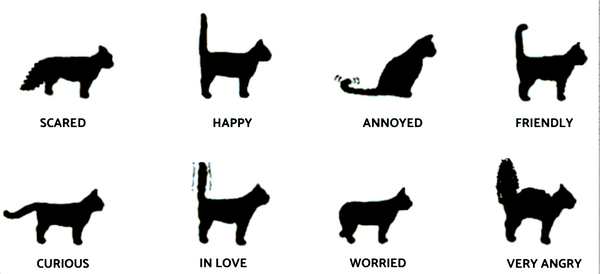
Cats have incredibly sensitive hearing and other senses, which means they might be able to hear things you cannot. What else is happening at the time, and what other behavior is your cat exhibiting?ĭetermine whether there are any new sounds or motions that might be spooking or upsetting your cat.

But, if you want to know whether something is bothering your cat or what an action or behavior is likely to mean, you should consider the context. It can also twitch, which is a vibration of the end or through the whole of the tail, and there are various reasons for this particular action.īelow, we have highlighted some of the most likely causes of a vibrating tail, whether it should concern you, and what you can do to remedy any potential problems that are causing it.Ĭats can seem unpredictable. It is important to consider context, but his or her tail can swoosh, wag, perk up, or remain motionless.
BASE OF CAT TAIL QUIVER MEANING SERIES
Rachael Moshman is a writer and owner of four cats.A quivering cat tail is just one of a series of ways in which your cat communicates with you. As such, this body language indicates feelings of trust.įor information on why your cat may engaging in another common behavior, check out Cat Purring: Why Does Your Pet Make This Noise? If an animal in the wild closed her eyes or exposed her stomach, this would open her up for attack. For example, if your cat exposes her stomach or takes a long blink while looking at you, she’s showing that she feels extremely comfortable with you. It’s how they communicate with other cats.”īut cats show their emotions through other types of body language, as well, explains Dr. “Otherwise, moving their tail is an important part of feline body language. “The exception would be a cat with an injured tail, of course,” she adds. Kennedy, almost all cats wag their tails. This is a sign of security! Just think of this gesture as your pet’s way of saying, “I acknowledge you, but I feel safe enough to keep my eyes closed.”Īccording to Dr. You might notice your sleeping cat’s tail twitches slightly when you pet or talk to her. If you see your pet’s tail swooshing back and forth, you may see her leap into action soon afterward. For instance, your cat may flick her tail if she wants you to stop petting her.Ĭats swoosh their tails back and forth when they are in hunter mode as a way to mesmerize prey. Similarly, an agitated cat will flick her tail. In fact, cats often engage in this tail behavior when they are on the vet’s exam table. Unlike their canine companions, cats often wag their tails back and forth when they’re annoyed. If this is the case, she will typically be backed up against the edge of the litter box, a wall or a piece of furniture. Your cat might also exhibit this posture when she’s urinating or marking her territory. Perhaps you have whipped out the catnip or have just arrived home from a long day at work. If your cat’s tail is upright and shaking from the base up, this typically means that she’s excited. On the other hand, if your cat has an erect tail, arched back and pushed-back ears, she is showing that she is scared but willing to fight the aggressor in question - whether that be another animal or an innocent object that has spooked her, such as a leaf blowing in the wind. This position indicates that she does not want to engage in conflict. If your furry friend is extremely afraid, she may even tuck her tail between her legs in submission. This is a playful stance that lets other cats - and you! - know that your pet is open for interaction.Ī cat who is feeling scared may wag her tail low to the ground.

Here are six reasons why your cat may be engaging in this behavior:Ī confident, happy cat will walk around with her tail straight up, gently wagging at the tip. Here’s everything you need to know about your furry friend’s tail wagging. In fact, there are several reasons why your cat may be moving her tail in this manner. Blain Kennedy, a veterinarian at Florida Veterinary League in Vero Beach, Florida. But what about your cat? Have you ever asked yourself, “Why do cats wag their tails?” “Most owners and cat sitters are surprised to learn it often is not a sign of a happy kitty,” says Dr. It’s a universally acknowledged truth that your dog is happy when his tail is wagging.


 0 kommentar(er)
0 kommentar(er)
